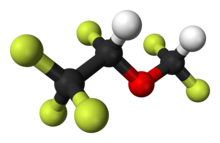デスフルラン

 | |
 | |
| IUPAC命名法による物質名 | |
|---|---|
| |
| 臨床データ | |
| 発音 | des-FLOO-rane |
| 販売名 | Suprane |
| Drugs.com | |
| ライセンス | US Daily Med:リンク |
| 胎児危険度分類 | |
| 法的規制 | |
| 投与経路 | Inhalation |
| 薬物動態データ | |
| 代謝 | Not metabolized |
| 半減期 | 分時換気量に依存する |
| 識別 | |
| CAS番号 |
57041-67-5 |
| ATCコード | N01AB07 (WHO) |
| PubChem | CID: 42113 |
| IUPHAR/BPS | 7156 |
| DrugBank |
DB01189 |
| ChemSpider |
38403 |
| UNII |
CRS35BZ94Q |
| KEGG |
D00546 |
| ChEBI |
CHEBI:4445 |
| ChEMBL |
CHEMBL1200733 |
| 化学的データ | |
| 化学式 | C3H2F6O |
| 分子量 | 168.04 g·mol−1 |
| |
デスフルラン(1,2,2,2-テトラフルオロエチルジフルオロメチルエーテル)は、全身麻酔の維持に使用されるハロゲン化エーテルの一種である。ハロタン、エンフルラン、イソフルランと同様に、(R)と(S)の光学異性体(エナンチオマー)のラセミ混合物である。人体への使用に関しては、セボフルランと同様、イソフルランに徐々にとって代わりつつある。発展途上国においては高価なために普及が遅れている。血液への溶解度が低いため、全身麻酔に使用される揮発性麻酔薬の中では最も効果の発現と消失が迅速である。商品名はスープレン。吸入麻酔薬としてのカラーコードは青。製品容器や専用気化器には青い色帯がある。
デスフルランのいくつかの欠点は、力価が低いこと、刺激性があること、およびコストが高いことである(ただし、新鮮ガスの流量が少ない場合、デスフルランとイソフルランのコストの差はほとんどないように思われる[1])。10%を超える濃度で投与すると、頻脈および気道過敏症を引き起こす可能性がある。この気道過敏性のため、デスフルランは、緩徐導入に使用されることはほとんどない。
気化しやすいが、常温では液体である。麻酔器には、液体のデスフルランを一定の温度に加熱する特殊な麻酔気化器ユニットが取り付けられている。これにより、一定の蒸気圧で薬剤を利用できるようになり、周囲温度の変動が麻酔器の新鮮ガス流量に与える薬剤の濃度に及ぼす影響を打ち消すことができる。
デスフルランは、エンフルランおよびより少ない程度のイソフルランとともに、麻酔回路内の二酸化炭素吸収剤と反応して、麻酔薬の分解を通じて検出可能なレベルの一酸化炭素を生成することが示されている。CO2吸収剤バラライムは、乾燥すると、デスフルランの分解による一酸化炭素の生成に最も影響を与えるが、吸収剤ソーダライムでも見られる。二酸化炭素吸収剤の乾燥状態は、大量の新鮮ガス流量に起因するものなど、この現象を助長する[2]。吸入麻酔薬の中では最も、地球温暖化への悪影響が強い。
薬理学[編集]
デスフルランは、GABAAおよびグリシン受容体の陽性アロステリックモジュレーター[3][4][5]およびニコチン性アセチルコリン受容体の陰性アロステリックモジュレーター[6][7]として作用し、他のリガンド依存性イオンチャネル[8][9]に影響を及ぼすことが知られている。
立体化学[編集]
デスフルランは、2つのエナンチオマーのラセミ体である[10]。
| デスフルランの鏡像異性体 | |
|---|---|
 (R)-エナンチオマー |
 (S)-エナンチオマー |
物理的特性[編集]
| 沸点 : | 23.5℃または74.3°F | (1気圧時) | |
| 密度 : | 1.465g/cm³ | (20℃) | |
| 分子量 : | 168 | ||
| 蒸気圧: | 88.5kPa | 672mmHg | (20℃) |
| 107kPa | 804mmHg | (24℃) | |
| 血液:ガス分配係数: | 0.42 | ||
| 石油:ガス分配係数 : | 19 | ||
| MAC : | 6体積% |
地球温暖化の可能性[編集]
デスフルランは温室効果ガスである。デスフルランの20年間の地球温暖化係数、GWP(20)は3714であり[11]、これは、排出される1トンのデスフルランが大気中の3714トンの二酸化炭素に相当し、セボフルランやイソフルランよりもはるかに高いことを意味する。麻酔ガス間の有意義な比較のためには、地球温暖化係数に加えて、薬剤の効力と新鮮ガス流量を考慮する必要がある。セボフルランは2リットル/分(LPM)、デスフルランとイソフルランは1LPMで最小肺胞濃度(MAC)1回に必要な定常時の麻酔薬の量をGWPで重み付けすると、それぞれの麻酔薬の臨床的な量を比較することができるようになる。MAC時間当たりで見ると、デスフルランのライフサイクル全体のGHG影響は、イソフルランとセボフルラン(1最小肺胞濃度時間)よりも20倍以上高い[12]。世界で使用されている麻酔ガスは、100万台の自動車に相当する量が地球温暖化に寄与しているという説もある[13]。この推定は、麻酔科医が公害防止を軽視している理由としてよく挙げられるが、これには問題がある。この推定値は、米国の1つの施設の麻酔慣行のみから推定されたものであり、この施設は実質的にはデスフルランを使用していない。研究者は亜酸化窒素を計算に入れなかったため、1回の麻酔につき17kgのCO2という誤った平均値を報告している。ただし、一部デスフルランを使用し、亜酸化窒素を使用している施設は、麻酔1回あたり平均175~220kgCO2を報告している。したがって、吸入麻酔薬の地球温暖化への寄与は過小評価されている可能性が高く、Sulbaek-Andersonのグループは依然、吸入麻酔薬の排出防止を提唱している[14]。
参考文献[編集]
- ^ John Varkey (2012年). “Cost Analysis of Desflurane and Sevoflurane: An Integrative Review and Implementation Project Introducing the Volatile Anesthetic Cost Calculator”. 2022年10月23日閲覧。
- ^ Fang (1995年). “Carbon Monoxide Production from Degradation of Desflurane”. Anesthesia and Analgesia. 2022年10月23日閲覧。
- ^ Hugh C. Hemmings; Philip M. Hopkins (2006). Foundations of Anesthesia: Basic Sciences for Clinical Practice. Elsevier Health Sciences. pp. 290–291. ISBN 0-323-03707-0
- ^ Ronald D. Miller; Lars I. Eriksson; Lee A Fleisher; Jeanine P. Wiener-Kronish; Neal H Cohen; William L. Young (20 October 2014). Miller's Anesthesia. Elsevier Health Sciences. pp. 624–. ISBN 978-0-323-28011-2
- ^ Koichi Nishikawa & Neil L. Harrison (2003). “The actions of sevoflurane and desflurane on the gamma-aminobutyric acid receptor type A: effects of TM2 mutations in the alpha and beta subunits”. Anesthesiology 99 (3): 678–684. doi:10.1097/00000542-200309000-00024. PMID 12960553.
- ^ Allan P. Reed; Francine S. Yudkowitz (2 December 2013). Clinical Cases in Anesthesia. Elsevier Health Sciences. pp. 101–. ISBN 978-0-323-18654-4
- ^ Paul Barash; Bruce F. Cullen; Robert K. Stoelting; Michael Cahalan; Christine M. Stock; Rafael Ortega (7 February 2013). Clinical Anesthesia, 7e: Print + Ebook with Multimedia. Lippincott Williams & Wilkins. pp. 470–. ISBN 978-1-4698-3027-8
- ^ Charles J. Coté; Jerrold Lerman; Brian J. Anderson (2013). A Practice of Anesthesia for Infants and Children: Expert Consult – Online and Print. Elsevier Health Sciences. pp. 499–. ISBN 978-1-4377-2792-0
- ^ Linda S. Aglio; Robert W. Lekowski; Richard D. Urman (8 January 2015). Essential Clinical Anesthesia Review: Keywords, Questions and Answers for the Boards. Cambridge University Press. pp. 128–. ISBN 978-1-107-68130-9
- ^ Rote Liste Service GmbH (Hrsg.): Rote Liste 2017 - Arzneimittelverzeichnis für Deutschland (einschließlich EU-Zulassungen und bestimmter Medizinprodukte). Rote Liste Service GmbH, Frankfurt/Main, 2017, Aufl. 57, ISBN 978-3-946057-10-9, S. 175.
- ^ Ryan, Susan M.; Nielsen, Claus J. (July 2010). “Global Warming Potential of Inhaled Anesthetics: Application to Clinical Use”. Anesthesia & Analgesia (San Francisco, CA: International Anesthesia Research Society) 111 (1): 92–98. doi:10.1213/ane.0b013e3181e058d7 2011年9月9日閲覧。.
- ^ “Life Cycle Greenhouse Gas Emissions of Anesthetic Drugs”. Anesthesia and Analgesia 114 (5): 1086–1090. (May 2012). doi:10.1213/ANE.0b013e31824f6940.
- ^ “Inhalation anaesthetics and climate change”. British Journal of Anaesthesia 105 (6): 760–766. (July 2010). doi:10.1093/bja/aeq259. PMID 20935004.
- ^ Sherman. “Estimate of Carbon Dioxide Equivalents of Inhaled Anesthetics in the United States”. American Society of Anesthesiologists. American Society of Anesthesiologists. 2015年6月3日閲覧。
参考資料[編集]
- Eger, Eisenkraft, Weiskopf. The Pharmacology of Inhaled Anesthetics. 2003.
- Rang, Dale, Ritter, Moore. Pharmacology 5th Edition. 2003.
- Martin Bellgardt: Evaluation der Sedierungstiefe und der Aufwachzeiten frisch operierter Patienten mit neurophysiologischem Monitoring im Rahmen der Studie: Desfluran versus Propofol zur Sedierung beatmeter Patienten. Bochum, Dissertation, 2005 (pdf)
- Susanne Lohmann: Verträglichkeit, Nebenwirkungen und Hämodynamik der inhalativen Sedierung mit Desfluran im Rahmen der Studie: Desfluran versus Propofol zur Sedierung beatmeter Patienten. Bochum, Dissertation, 2006 (pdf)
- Patel SS, Goa KL (1995). “Desflurane. A review of its pharmacodynamic and pharmacokinetic properties and its efficacy in general anaesthesia”. Drugs 50 (4): 742–67. doi:10.2165/00003495-199550040-00010. PMID 8536556.
外部リンク[編集]
- “Desflurane”. Drug Information Portal. U.S. National Library of Medicine. 2020年7月19日閲覧。
